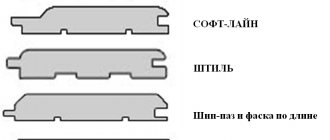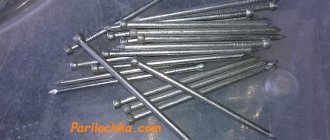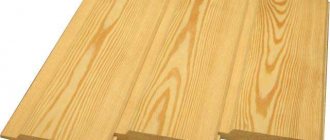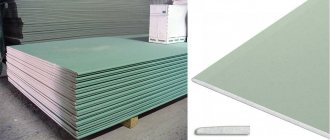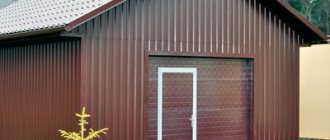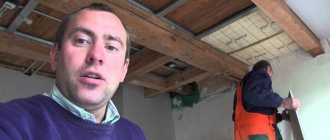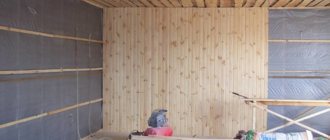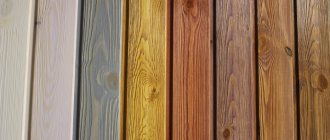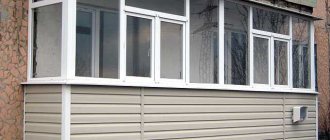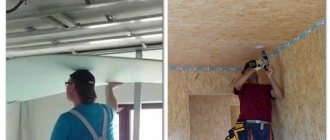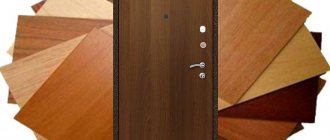A garage is primarily a technical room, and therefore the requirements for its arrangement and microclimate are somewhat different. Accordingly, the materials used for interior decoration of residential premises are not always suitable for repairing a garage box. Finishing a garage with clapboard is one example of a successful solution.
Garage Ceiling Finish
Why do you need garage lining inside?
Finishing the garage will keep the room dry and warm. The creation of such conditions is necessary to keep things in the garage, as well as the vehicle, safe and sound.
If finishing work is not carried out, the humidity in the room will always be high.
Dampness will contribute to the beginning of the process of rotting of the car and the appearance of rust on its spare parts. Tools and other things stored in the garage will also deteriorate.
Finishing work is intended not only to create an aesthetic appearance in the garage, but also to maintain hygienic conditions in it. And working in a warm, well-maintained garage is much more comfortable.
Useful video: mastering the principle of working with lining
You will definitely find this helpful video useful. Watch the following video to understand all the key rules for working with this material. You must be able to handle the lining correctly and install it correctly.
If you are careful and act wisely, this lining finish will last for many decades, maintaining its excellent technical characteristics.
A garage is primarily a technical room, and therefore the requirements for its arrangement and microclimate are somewhat different. Accordingly, the materials used for interior decoration of residential premises are not always suitable for repairing a garage box. Finishing a garage with clapboard is one example of a successful solution.
Garage ceiling decoration.
[my_custom_ad_shortcode2]
Options
Since a lot of work is carried out with various chemicals, finishing work must be done from exclusively high-quality, proven materials. Let's take a closer look at how you can decorate a garage.
Plaster
Plaster has become less and less used for finishing work, since it is very difficult to work with it, especially if there are no special skills. In damp and cool weather, this material dries completely only after a few days.
Suitable for both wall and ceiling decoration. You most likely won’t be able to create a neat and high-quality plaster finish yourself and will have to hire a specialist.
Plaster tends to burst due to temperature changes. Over time, the appearance of such cladding deteriorates greatly - the plaster becomes dull and quickly becomes dirty. Getting rid of dirt on plastered walls is not easy.
How to do the finishing yourself?
Whatever building material you choose when finishing a garage, you need to know how to work with each of them, where to start and what stage of finishing should be next.
Floor preparation is the initial step when carrying out interior finishing work in the garage. Porcelain stoneware is mainly used for floor finishing . But they only lay it on a concrete-filled, perfectly flat, completely dry floor.
The tiles are attached using a special glue that is resistant to temperature changes.
If the concrete used to fill the floor is old and chipped, you can use a leveling mixture to level it. But before that, the floor is thoroughly cleaned of debris and dust , and then covered with a special primer - it is applied with a roller.
While applying the leveling mixture to the floor, all windows and gates must be closed . The mixture is applied using a leveler only after the primer has completely dried.
Watch this video to see how to finish a garage floor with porcelain stoneware:
After preparing the base, you can begin laying the tiles. Apply glue to a small area of the floor (no more than 1 sq.m.) in an even, not and level it with a spatula.
Then the tiles are laid one by one, inserting a special cross between each one , designed to maintain equal spacing between the tiles.
If necessary, the tiles are cut with a special machine, but it is recommended to leave these parts near the baseboard so that the appearance of the laid tiles looks aesthetically pleasing. In order not to “move” to the side when laying, you can stretch transverse ropes over the floor.
Ceiling
Before decorating the ceiling, you need to make sure that moisture will not penetrate into the room through the ceiling and heat will not escape.
Plastic panels are often chosen for its cladding. The reason for this is the lightness of the material, since you have to work with them at height. They are also economical and practical.
Do you know how to glue foam ceiling plinths? More information here.
They are attached to the ceiling on a prepared frame. To ensure it is assembled correctly, you must perform the following steps:
- Make precise markings along the entire perimeter of the ceiling.
- If the garage has a slope and all its corners are at different heights, first, using a water level, you need to determine the lowest of them - it will be the reference one.
- Also, using a water level, this height is marked on the opposite wall, in the same corner.
- The resulting two points must be connected to each other using a rope and measurements taken at the same height in the remaining two corners.
- As a result, 4 ropes should be stretched along the perimeter of the ceiling at the same height, along which the frame is attached.
- to attach guide metal profiles to each wall , which are secured with dowels.
- The intermediate frame elements are attached to the guide profiles at intervals that will be equal to the dimensions of the panels. But this distance should not be more than 50 cm.
In the following video, watch how to sheathe a ceiling in a garage:
The panels are inserted into the prepared frame with a shim into the groove of the previous element. The most difficult ones to secure are those that should be located against the wall. If necessary, they can be cut to the desired size by stepping back from the side that will meet the wall.
Preparation for installation of lining
Due to the fact that the individual elements will be fixed to the frame, leveling the wall surface is not a necessary step if the garage is covered with clapboard.
Stages of fastening the lining.
To prepare the frame and install the sheathing, you will need the following tools and materials:
- wooden block 20x40 mm or metal profile (for PVC panels);
- lining made of wood, PVC or MDF;
- nails, dowels depending on the material of the garage wall;
- hacksaw or electric saw;
- drill or hammer drill;
- hammer;
- building level, plumb.
When installing the frame, you need to take into account the direction in which the finished sheathing elements will be located. It is important to follow the rule: the frame bars should always be directed perpendicular to the direction of the lining elements.
Having determined the desired direction of the block, mark the walls and ceiling:
- beat off horizontal and vertical;
- mark the places where the bars are attached in increments of 50-60 cm;
- drill holes for dowels (when fastening to nails, self-tapping screws) or dowels.
Before installing the frame, cover the walls and ceiling of the garage with a vapor barrier material to prevent moisture from condensing on the cold surface under the sheathing.
Types of lining profiles.
This can cause the wood panels to rot.
When installing bars, you should constantly check the verticality of the structure using a plumb line. To level the block, wooden wedges are used, which are fixed to the wall when it deviates from the vertical. For the same purpose, it is convenient to use metal hangers for guide profiles for drywall. The bars are attached to the profile using wood screws in the holes in the hangers intended for this purpose, and the hangers themselves are mounted on the wall or ceiling of the garage with dowels or self-tapping screws in dowels.
If there is a need to insulate the walls of the garage, then after the installation of the frame is completed, heat-insulating material of the required thickness is laid between its bars.
Finishing requirements: features
What are the requirements for a garage box:
- The difference between the outside temperature and the temperature in the box should not be large; for this reason, the box does not need to be additionally heated or cooled. If you plan to carry out renovation work indoors, then the internal temperature should be more or less acceptable; this is achieved through good thermal insulation.
- Often, a lot of spare parts and tools, and sometimes flammable substances, are stored in the garage. It is better to sheathe the walls and ceiling with either poorly burning materials or (ideally) non-flammable ones. Fire safety should be a priority.
- During the cold season, there is a possibility of moisture accumulating in the form of condensation, which is detrimental to materials, so preference should be given to those that are resistant to rot and are not susceptible to moisture.
- It's not easy to keep a garage clean, so the sheathing should be easy to clean.
When calculating the amount of lining, you need to remember that its length does not always coincide with the width of the ceiling or the height of the room.
Covering a garage with clapboard is an excellent solution, you just need to choose it correctly. The lining can be made of plastic or wood, both types have their advantages. The installation principle is the same for both types; you can easily do it yourself. When choosing lining, you need to proceed from the specific needs and characteristics of the room.
Tools you will need:
Which is better to choose: plastic or wood?
In fact, both materials have advantages and disadvantages, they are actively used for both internal and external work, but there is a difference - the thickness of the lamellas, so take this into account.
So:
- The installation principle is the same, in addition, it can be easily done with your own hands, so there should be no problems.
- Wooden lining is popular today. Of course, it is not at all necessary to use mahogany slats for lining a garage, but this does not mean that you should not pay close attention to the type of wood. But the price of this material will be significantly higher than plastic.
- If severe winters are common in your region, then know that you need to use only wooden lining.
- Wood is also vapor permeable, which means it is able to absorb and release moisture from the air, as a result of which a favorable microclimate reigns in the room, which is important.
- Moisture resistance should be low; it is for this reason that before installation, the lamellas must be treated with special protective agents, and then varnished; this is the most important condition.
Attention: Moreover, you need to take into account that in the future you must repeat this procedure. The wooden surface will have to be constantly maintained, otherwise it will lose its appearance.
Keep in mind that the quality directly depends on the wood you choose, for example, ash does not tolerate temperature changes well, this is its characteristic feature, and as for larch, it is insensitive to the action of water, so be sure to take this into account.
Plastic lining
PVC lining for garages is used quite often. She has her own merits that are difficult to dispute.
So:
- It is chemically inert , but is not interesting to rodents, which is its main advantage.
- This lining is moisture resistant , it is not subject to rotting, the action of fungi, it is fireproof, in addition, it is also distinguished by thermal insulation, although it is noticeably inferior to wood.
- It is installed similarly to wood , so this side is the same whichever you choose.
Wood lining: characteristics
The quality characteristics of wooden lining largely depend on the type and species of wood. Of course, mahogany is unlikely to be used for these purposes, but you should not deprive it of attention: its qualities are quite suitable, and mostly red species can be used. What qualities does wood lining have:
Wooden lining is distinguished by its maximum performance in terms of heat and sound insulation.
- The highest possible indicators for sound and heat insulation. Ideal for harsh, long winters.
- Wood has the unique property of creating and regulating the microclimate in any room. If the walls and ceiling of the box are covered with wooden clapboard, then you don’t have to worry about vapor permeability. Wood can provide the necessary degree of comfort.
- Moisture resistance indicators are average, so before starting work it is necessary to treat the slats with a product that protects against moisture and open them with varnish. The coating will have to be renewed periodically, the frequency will depend on the type of tree, for example, ash has a negative attitude towards changes in humidity, while larch, on the contrary, does not react to the influence of water, so it can even be used to decorate the outside of a building.
- An important point is the degree of resistance to fungus and rot; to improve performance, treatment with special substances is necessary. In this regard, coniferous species outperform deciduous species due to the resin content in them.
Types of lining
First, let's look at the main types of lining. Craftsmen often divide the material into two types. The lining can be “regular” or “euro”.
Everyone knows that the so-called eurolining not only differs in parameters, thickness and width, but also in quality itself. This material is better processed, easier to install, and looks more aesthetically pleasing. Conventional lining is also in demand because it has its own significant advantage: with decent technical characteristics, it attracts at an affordable price.
Lining is made from various types of wood, both deciduous and coniferous. Hardwood material is more suitable for interior finishing work. Coniferous species are equally suitable for interior and exterior decoration.
The lining is divided into grades. Experts note that grade “C” is also quite suitable for finishing the inside of a garage, since there are no special, very high requirements for its appearance and design.
In addition, there is a special plastic lining. It allows you to achieve good results, while installation is even easier and faster.
[my_custom_ad_shortcode1]
Lining made of plastic
Plastic lining is not susceptible to the influence of various microorganisms.
Plastic lining is a relatively new type of finishing. The production material is polyvinyl chloride, which is quite popular today. It is chemically inert, does not attract rodents, and is also not a favorable environment for the habitat of various microorganisms.
In addition, it has the following qualities:
- insensitive to moisture, which means moisture resistant;
- not susceptible to rotting and fungus;
- plastic is a fireproof material, does not burn well and does not emit substances that poison the body;
- in terms of heat and sound insulation qualities it is significantly inferior to wood;
- It is easy to maintain - if necessary, you can simply wipe it with a cloth.
Characteristics of plastic lining
Plastic lining appeared on the market not so long ago, but has already gained popularity and trust. Such plates are made from polyvinyl chloride. Here are its main technical properties.
- The lining is not afraid of rotting, mold and mildew.
- The material is not dangerous for rodents, and microorganisms do not grow in it.
- Plastic provides a decent level of fire safety.
- This type of finish is easy to care for: the plastic lining is easy to clean, you can simply wipe it down or do a wet cleaning.
True, if we talk about thermal insulation and noise protection, plastic lining is significantly inferior to wooden finishing material.
[my_custom_ad_shortcode5]
Cladding finishing: technology
Scheme of wall cladding with PVC clapboard.
Covering a room with clapboard is not that difficult; it is quite possible to do the installation yourself. The installation process is similar, the difference is in the joining and the nature of the fasteners: lamellas made of plastic need to be connected with a tongue and groove, and those made of wood need to be overlapped. How to line a garage with clapboard:
- The starting stage is the creation of the sheathing. The material can be a galvanized profile or a wooden beam (more often used in decorating garages).
- The slats need to be placed depending on the installation method: if the slats are placed horizontally, then the lathing needs to be done vertically, and vice versa. Using the same principle, the sheathing is mounted on the ceiling. Fastened with galvanized nails or self-tapping screws.
- If you plan to insulate the garage, then it needs to be done at this stage: place waterproofing between the slats, then insulation and then a layer of vapor barrier. Fiberglass (which rodents are very afraid of) or mineral wool will do an excellent job as insulation.
- The sheathing process must begin either from the left corner of the wall or from the bottom up. If plastic lining is chosen as the material, then the process begins with fixing the starting panel and then attaching the main lamella to it.
- The slats need to be joined tightly; if the lining is made of wood, it is recommended that the seams be additionally treated with sealant.
- The finished wooden lining must be coated with varnish, ideally fire-resistant.
Advantages of lining
Let's pay attention to the key advantages of lining as a finishing material for a garage.
- The lining is environmentally friendly. It does not emit toxic compounds and is completely safe for health.
- The material is easy to process. For example, the lining is tinted, giving it almost any desired shades.
- This finish attracts with its durability. It practically does not rot. Even wood planks are not afraid of moisture, since they are subjected to special treatment.
- There is no need to specially prepare the surface for clapboard covering. However, craftsmen still advise making a special frame to speed up the installation process and make the final surface more durable.
- You can easily install hidden communications, such as wiring, under the material.
- If you finish it with clapboard, the room will acquire good sound and thermal insulation properties. Moreover, the method is economical. You immediately receive a finishing layer, as well as properties that are useful from a practical point of view.
It is noteworthy that almost anyone can handle the installation of lining, without special training or professional skills. The main thing is to remember useful recommendations. Now we will learn how to line a garage with clapboard correctly.
[my_custom_ad_shortcode2]
How to calculate the required amount of lining
To sheathe a garage, it is advisable to immediately stock up on everything you need. If you calculate using the formula “the number of linings is equal to the area of the room,” then this is completely wrong. The length of the lining rarely completely coincides with the width of the ceiling or the height of the room, which means that part of it will go to scraps.
It is important to perform the calculation correctly, taking into account the length of the board.
Before you start covering, you need to decide on the location of the lining - vertically or horizontally, then find out the length of the slats. When purchasing, you need to add at least 5% to the total number; it’s better to have a little left over than to have to go to the store for one or two boards.
How to properly line a garage with clapboard?
Basic parameters of the lining.
When the sheathing elements are arranged vertically, it is customary to start work from the left corner. Try the initial board of the row against the surface of the wall, process the edge adjacent to the corner with a plane if the wall has unevenness. Carefully check the verticality of the element in 2 planes and secure it to the guides.
Cladding with clapboard when the elements are arranged horizontally begins from the bottom up. The board adjacent to the floor is secured first. Check it for horizontalness of the top edge and verticality of the front surface.
When the boards are arranged diagonally, the linings start with the longest element, then moving up and down from it. The exact placement of the initial board is important, since all subsequent cladding parts will be oriented towards it. In this case, the verticality of the front surface and the perpendicularity of the board to the frame bars are verified.
[my_custom_ad_shortcode3]
Practical advice from the master
Eurolining must be varnished in one layer before installation.
If you decide to cover a garage box with clapboard, then you need not only to know the installation technology, but also some tricks of the job.
- If the slats are laid along the ceiling, the room will visually become longer; if the slats are placed crosswise, the garage will appear wider.
- The planks for creating the frame must be smooth, there should be no knots or splits.
- Walls and ceilings that have unevenness must be leveled at the stage of attaching the frame.
- If the finishing used was not eurolining, but simple, then inspect it for roughness. If there are any, they need to be sanded. It is better to varnish a simple lining in two layers; for euro-lining, one is enough.
- If electrical (and sometimes plumbing) work is necessary, it must be completed before the sheathing begins.
- The sheathing can be treated with an antiseptic and then the sheathing process can be carried out.
- The last rail may turn out to be wider than necessary, so in this case it needs to be loosened to the desired width and secured with self-tapping screws.
- To hide the seams and connections, you can use decorative cladding in the form of corners and strips.
If you don’t know which garage finish to choose, then take a closer look at the lining. Sheathing the ceiling and walls with clapboard is not so difficult, but the sheathing will last you for many years. Cover the garage box with plastic or wood if desired and get a reliable finish and an aesthetic appearance.
In this post I will talk about the process of insulating and sheathing a garage.
First of all, you need to determine what materials will be used as a frame for the sheathing, what the actual insulation will be, and what to cover the whole thing with. There are many options here, depending on taste, color and wallet.
As a material for sheathing
I chose a beam of natural humidity 5*5 cm. An alternative option was to use metal guides, which are used when installing gypsum board. I chose wood because, as it seemed to me then, it was easier and more pleasant to work with. In fact, after that, I realized that the metal frame is still easier to assemble and it gives much more possibilities in shaping surfaces.
Choice of insulation
essentially came down to a choice between mineral wool and polystyrene foam. With a similar thickness, they have a similar thermal conductivity coefficient. I chose foam plastic because... he is not afraid of moisture. If mineral wool is used as insulation, then it is necessary to isolate it from moisture with an additional membrane. Plus, foam plastic is easy to cut and lay, and even holds itself if you fit the slabs end-to-end. The disadvantages of polystyrene foam are that mice can eat it, and it is also highly flammable. To avoid such problems, I bought 4cm thick Knauf foam with fire retardant additives (fireproof) and a rodent repellent. 4 cm is not that much, but my goal is not to live in a garage, but only to maintain a comfortable minimum of 13-15 degrees at any time of the year. On top of the foam, as a membrane, I took craft paper with foil, as well as a stenophone. The essence of the material is as follows: it works as a membrane, preventing moisture from passing through, plus it has a foil layer that works as IR reflective insulation. These materials were chosen because as a source of heating for the garage, I chose an IR heater, which works precisely on the principle of IR heat radiation.
The last element is the cladding material
. There are generally a lot of options: you don’t have to cladding at all, you can use PVC sheets, gypsum board, OSB, chipboard, lining... Since I planned to load the walls (hang shelves and hooks, put up racks), I needed a fairly rigid material that could withstand load. The choice was between two materials of similar cost: lining and OSB boards. I chose forcing only because it looks more aesthetically pleasing. It’s unrealistically cozy in the garage, like in a bathhouse) On the other hand, OSB boards are much easier and faster to install, many times over, so by choosing them you can save a day or two of work.
Once you have purchased your materials, you can get started!
First of all, you need to saturate the timber with fire protection in several layers and let it dry. If this is not done, the wood will begin to become damp, rot, turn black and become flammable.
Having stained the timber, you can begin installing the sheathing, having first marked out for yourself at least an approximate diagram. It is necessary to provide for the spacing of the sheathing, mortgages, clearance from the ceiling and floor, etc. You can install it locally, but in this case there may be surprises.
At this stage, it is important to remember that if you plan to load a wall somewhere, then you need to provide embeds. Those. It would be nice to already have a plan for the future arrangement of the garage.
For example, in this place I will hang the tabletop of a folding workbench. To strengthen the structure along the entire length, I attach bars so that later everything hangs not only on the lining, but is attached more securely.
After the sheathing is installed, you can take on the insulation. Foam plastic is easy to cut and adjust, and it’s a pleasure to work with. The only thing is that everything around will be covered in white balls from him)
see also
Comments 22
Did you make the membrane on both sides of the foam? How is the effect? What do you use for heating?
The membrane is only on the inside, I heat it with gas. When it’s around zero, all you have to do is drive the car into the garage, it will be 15 degrees inside. At minus 20, they warm it up with a gas gun for 10 minutes, then turn on the IR gas heater, ventilate it for 5 minutes and get the same 15 degrees.
cool. How did you do the ceiling?
exactly the same as the walls, only the roof was redone from the outside!
Interesting garage size, is this in a regular GSK? Are all the garages 9 meters long?
Regular GSK, yes, there are rows of 6, there are 9, there are two-story ones with a lift of 60 meters
You can bring two cars (small ones) if you want! When I bought mine I could barely find 4x6, mostly all 3x6... In what area is your garage?
Rustaveli, I drove 2 cars: my wife’s Mazda and my five BMW – back to back)
Probably a lot of money was “spent” on insulation?!
Not really, just insulation and lining and membrane for about 20₽
20 rupees is 2/3 of my salary
well I have nothing to do with it)
It's clear. The possibilities and the horizon of work are wider.
Good afternoon. I need your recommendations regarding insulation of the garage roof. The fact is that during construction in the 80s, the following insulation was done: - boards were laid on the I-beams, after which screenings/slag were poured to the level of the I-beam. — all this was covered with a reinforced screed of approximately 15-17 cm + roofing felt. It so happened that the old owner neglected the garage to a deplorable state and over the course of many years the roof, boards, and screenings collected moisture and the boards rotted and the material began to crumble. The most characteristic thing is that the concrete was well preserved for so many years and during intense rainfall it allowed water to pass through only in a few places. After the screening was removed, I discovered that the concrete screed did not lie on the I-beams (wooden wedges were temporarily clogged).
